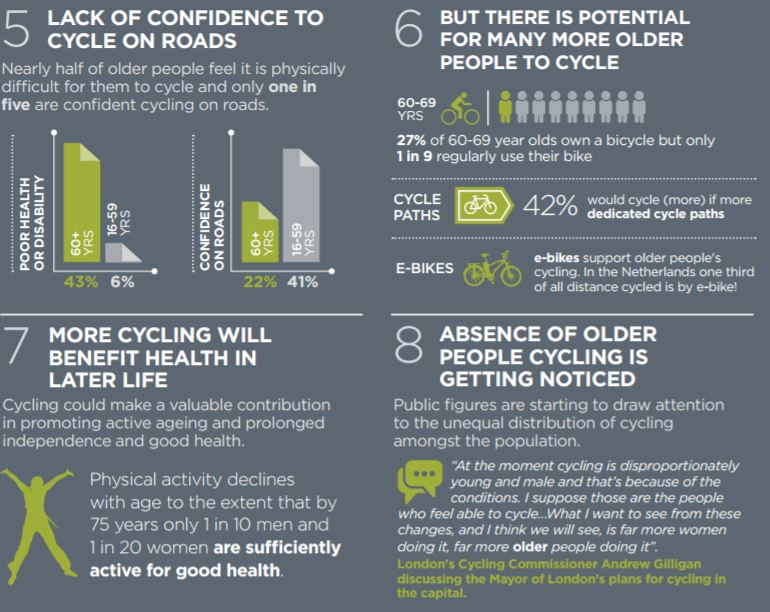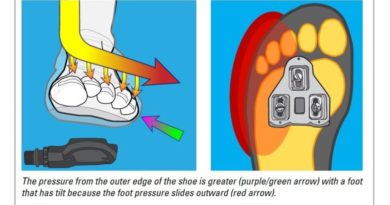Cycle Boom study concludes UK infrastructure discouraging older cyclists
A new study by the Oxford Brookes University has concluded that the UK is failing in prolonging cycle use into old age.
With an ageing population, particularly in Europe, researchers unsurprisingly determined that the UK  lags far behind neighbours on mainland Europe in over 60s cycle use. In fact, just 1% of journeys made by the over 60s in the UK are completed by bike. Just over the water, the Netherlands achieves a 23% rate, while Germany and Denmark’s over 60s rack up 9% of trips on two wheels.
lags far behind neighbours on mainland Europe in over 60s cycle use. In fact, just 1% of journeys made by the over 60s in the UK are completed by bike. Just over the water, the Netherlands achieves a 23% rate, while Germany and Denmark’s over 60s rack up 9% of trips on two wheels.
Taking three years to complete, the authors of the Cycle Boom paper involved 240 participants spanning Bristol, Reading, Oxford and Cardiff. These were both cyclists, non-cyclists, as well as older people who desired to cycle again having taken an extended break. These groups took part in an eight-week ‘cycling and wellbeing’ trial, designed primarily to measure the impact of cycling on both physical and mental health.
72% of over 60s surveyed in this study believe it is “too dangerous” to cycle on the road.
Participants in the study pledged to cycle outdoors for at least 30 minutes three times weekly over the trial period. Half of the users relied on an electric bike loan to complete the trial.
As has been the case in former e-bike trials, the majority of pedal-assisted users took to the experience, cycling well beyond the required time. Those physically limited were particularly enthused and commented that they had replaced short car journeys almost entirely in favour of the e-bike.
“There is the potential to engage a significant market of retired people contemplating cycling as part of a personal project for healthy ageing particularly given the growth in the availability and popularity of power-assisted cycles (e-bikes),” concludes the document on pedal-assist potential.
42% of over 60s stated they would cycle more if there a greater level of dedicated cycle paths were available.
The stumbling block for many is a familiar one. Respondents largely spoke of poor infrastructure to allow them to safely proceed from A to B for fear of injury. As has been demonstrated time and again, build it and they will come.
In its conclusion the report identifies three groups of existing older riders; Reluctant riders, Resilient Riders and “potentially significant market” Re-engaged riders. 
The latter group are described as having the time and income to devote to cycling. Those interviewed who had re-engaged reported that they had actively sought traffic free routes, many of which will not always be the most direct. Confidence to cycle near traffic was a common barrier.
“The cycling and wellbeing trial demonstrated their positive experience of cycling especially in circumstances where they felt they had control of their cycling activity i.e. when, where, how and with whom it took place. This was usually when riding in leisure spaces, but also for utility journeys away from busy streets and motor traffic,” said the study. “In summary, the key message that emerges from this study is that cycling is regarded as dangerous and the majority of the older population is therefore reluctant to cycle.
“A substantial shift in culture towards planning for older mobility is required if cycling is to be embedded in the lives of an increasingly older population. This will require a substantial shift in approach and policy across different sectors and partnership working at all levels in order to realise this ambition.”
The report offers six recommendations for the future:
1. Older people are not one homogenous group. This should be recognized when planning programmes to support older mobility. There is a need to challenge age stereotypes and portrayal of decline and dependency and instead portray a positive image of active ageing.
2. Older cycling is partial and resigned to specific times and spaces because of poor and largely unsupportive infrastructure for everyday cycling. This raises questions about spatial justice and of the need to engage older people in participatory approaches to designing public space for cycling at an early stage. Improvements that enable cycling by older people have broader benefits for pedestrians, drivers and other cyclists of different ages and abilities.
3. Cycling offers the potential for positive experience by providing older people with the means to participate in meaningful activity: to engage with landscape, foster personal relationships and maintain social contact with the outside world. The broader health and wellbeing benefits of cycling need to be recognized, promoted and supported through activities, events and programmes.
4. An ageing body throws up new challenges for cycling but new and rapidly evolving cycling technologies have the potential to promote and prolong cycling among the older population and make cycling enjoyable. Power assisted cycles (‘e-bikes’) and other technological innovations should be developed, promoted and supported as part of the health and sustainable mobility agenda.
5. Older cycling is precarious – a whole generation that has already acquired cycling skills is diminishing. Policies and programmes are required across sectors that involve multiple actors working together to deliver a broader age friendly cycling agenda as part of the government’s Cycling and Walking Investment Strategy. There is an urgent need to act now to develop the infrastructure fit for an ageing society.
6. The issue of unsupportive infrastructure and road danger for older cyclists is also relevant to children and young people. And while maintaining health is an issue for the older population, there is a prevalence of low levels of fitness and high levels of obesity among young people. Interventions targeted at promoting older cycling would, therefore, also support younger cycling and help to address these pressing social issues.
The Cycle Boom document was produced by:
Jones, T., Chatterjee, K., Spinney, J., Street, E., Van Reekum, C., Spencer, B., Jones, H., Leyland, L.A., Mann, C., Williams, S. & Beale, N. (2016). cycle BOOM. Design for Lifelong Health and Wellbeing. Summary of Key Findings and Recommendations. Oxford Brookes University, UK.
To read to Cycle Boom document in full, head here.
Cycle campaigner and need more evidence like this to build your case for cycling? Check out our Cycling Advocacy Resource.



